

Untitled Star Trek sequel. Star Trek (film) Development for Star Trek originated in 1968, when creator Gene Roddenberry announced plans to produce a prequel modeled after the television series.

Star Trek: Insurrection. Paramount Studios sought a change in pace after the previous film, Star Trek: First Contact.
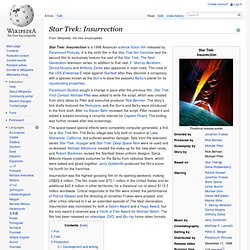
Michael Piller was asked to write the script, which was created from story ideas by Piller and executive producer Rick Berman. The story's first drafts featured the Romulans, and the Son'a and Ba'ku were introduced in the third draft. After Ira Steven Behr reviewed the script, Piller revised it and added a subplot involving a romantic interest for Captain Picard. The ending was further revised after test screenings. The space-based special effects were completely computer generated, a first for a Star Trek film. Plot[edit] Picard and his team discover a cloaked Federation ship containing a gigantic holodeck set up to recreate the Ba'ku village; Data's malfunction was due to a Son'a attack when he previously discovered the vessel.
Star Trek: Nemesis. Plot[edit] Upon their arrival on Romulus, the crew learns that Shinzon is actually a clone of Picard, following a secret experiment conducted by the Romulans to take Picard's place in Starfleet as a spy; however, he and the project were abandoned after a political change in the Romulan government left him cast away to Remus as a slave.
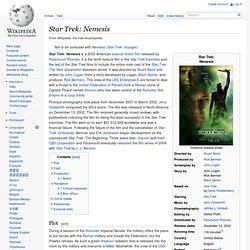
It is there that he meets his Reman brethren and effects his rise to power. It was also on Remus where Shinzon constructed his flagship, a heavily armed warship named Scimitar, with a completely undetectable cloaking device, an arsenal of weapons, and virtually impregnable shields. Though the diplomatic mission seems to go smoothly, the crew discovers that the Scimitar is emitting low levels of extremely dangerous thalaron radiation (the same radiation used to assassinate the Romulan senate), several unauthorized computer accesses take place aboard the Enterprise, and Troi is mentally attacked by Shinzon while she is having sex with Riker.
Star Trek II: The Wrath of Khan. After the lackluster critical and commercial response to Star Trek: The Motion Picture, series creator Gene Roddenberry was forced out of the sequel's production.

Executive producer Harve Bennett wrote the film's original outline, which Jack B. Sowards developed into a full script. Director Nicholas Meyer completed the final script in 12 days, without accepting a writing credit. Meyer's approach evoked the swashbuckling atmosphere of the original series, and the theme was reinforced by James Horner's musical score.
Leonard Nimoy only reprised his role as Spock because the character's death was intended to be irrevocable. The Wrath of Khan was released in North America on June 4, 1982. Plot[edit] Kirk arrives in the engine room, where Spock dies of radiation poisoning. Cast[edit] Star Trek: The Motion Picture. Released in North America on December 7, 1979, Star Trek: The Motion Picture received mixed reviews from critics, many of whom faulted the film for its lack of action and over-reliance on special effects.
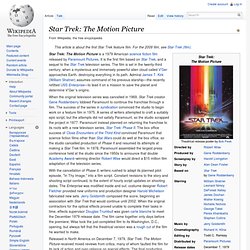
The final production cost ballooned to approximately $46 million. The film earned $139 million worldwide, falling short of studio expectations but enough for Paramount to propose a cheaper sequel. Roddenberry was forced out of creative control for Star Trek II: The Wrath of Khan. In 2001, Wise oversaw a director's cut for a special DVD release of the film, with remastered audio, tightened and added scenes, and new computer-generated effects. Plot[edit] At the heart of the massive ship, V'Ger is revealed to be Voyager 6, a 20th-century Earth space probe believed lost.
Cast[edit] Star Trek III: The Search for Spock. Star Trek IV: The Voyage Home. After directing The Search for Spock, cast member Leonard Nimoy was asked to direct the next feature, and given greater freedom regarding the film's content.
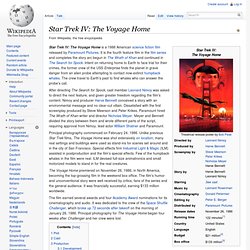
Nimoy and producer Harve Bennett conceived a story with an environmental message and no clear-cut villain. Dissatisfied with the first screenplay produced by Steve Meerson and Peter Krikes, Paramount hired The Wrath of Khan writer and director Nicholas Meyer. Meyer and Bennett divided the story between them and wrote different parts of the script, requiring approval from Nimoy, lead actor William Shatner and Paramount. Principal photography commenced on February 24, 1986. Unlike previous Star Trek films, The Voyage Home was shot extensively on location; many real settings and buildings were used as stand-ins for scenes set around and in the city of San Francisco. The Voyage Home premiered on November 26, 1986, in North America, becoming the top-grossing film in the weekend box office. Plot[edit] Cast[edit] Production[edit] Star Trek V: The Final Frontier. Star Trek VI: The Undiscovered Country.
The Undiscovered Country was initially planned as a prequel to the original series, with younger actors portraying the crew of the Enterprise while attending Starfleet Academy, but the idea was discarded because of negative reaction from the cast and the fans.
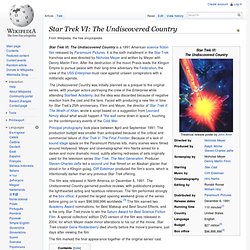
Faced with producing a new film in time for Star Trek's 25th anniversary, Flinn and Meyer, the director of Star Trek II: The Wrath of Khan, wrote a script based on a suggestion from Leonard Nimoy about what would happen if "the wall came down in space", touching on the contemporary events of the Cold War. Principal photography took place between April and September 1991. Star Trek: Generations. Star Trek Generations is a 1994 American science fiction film released by Paramount Pictures.

Star Trek: First Contact.